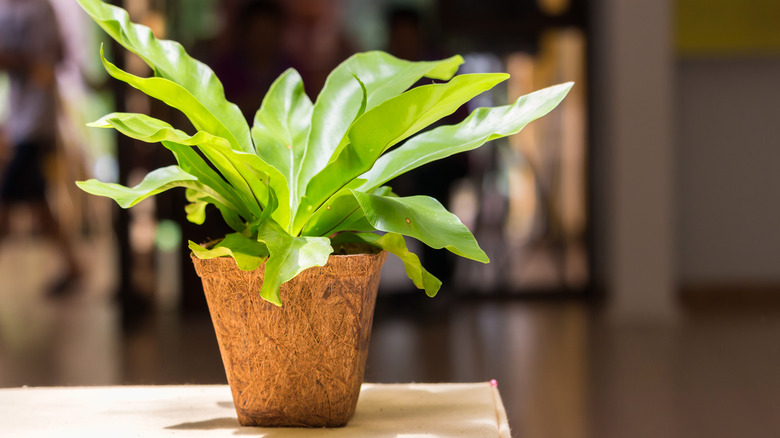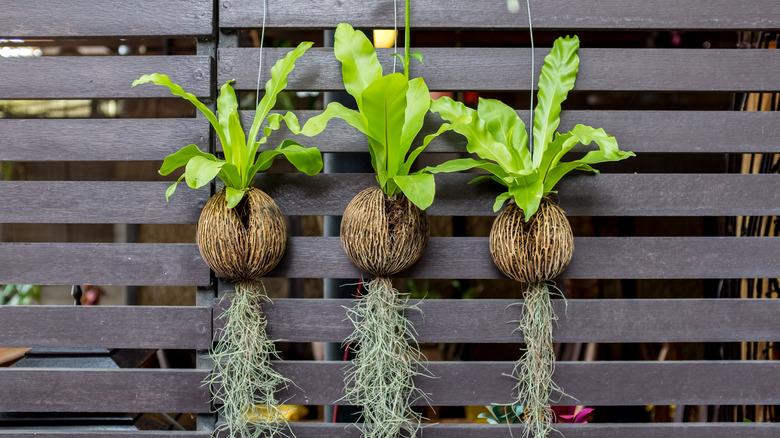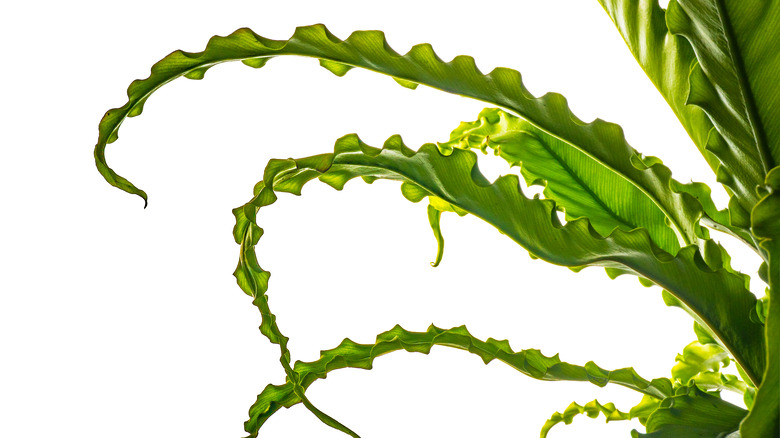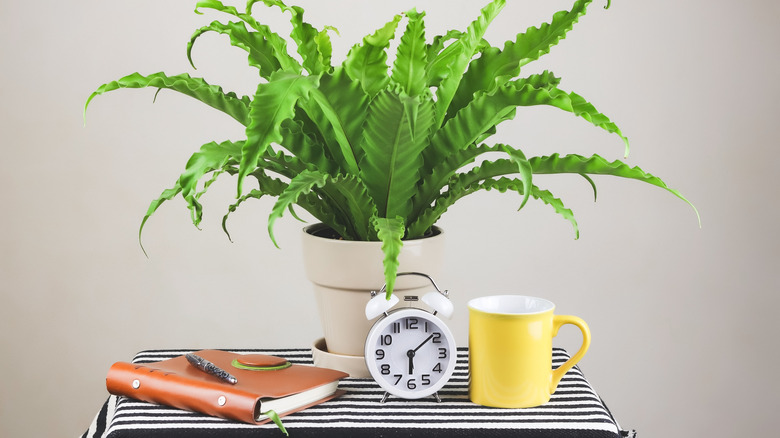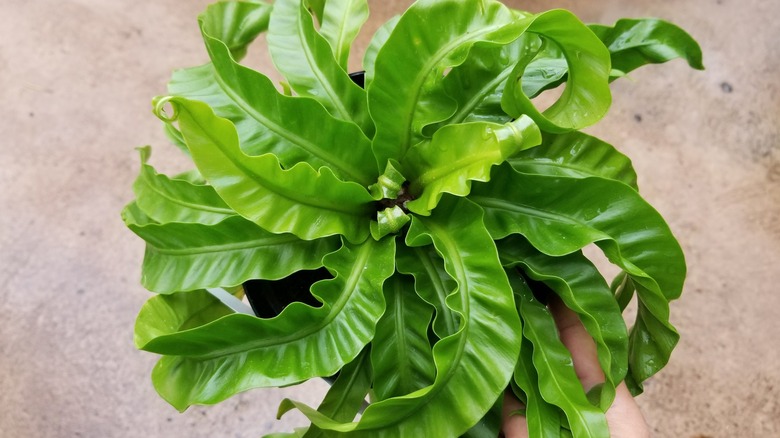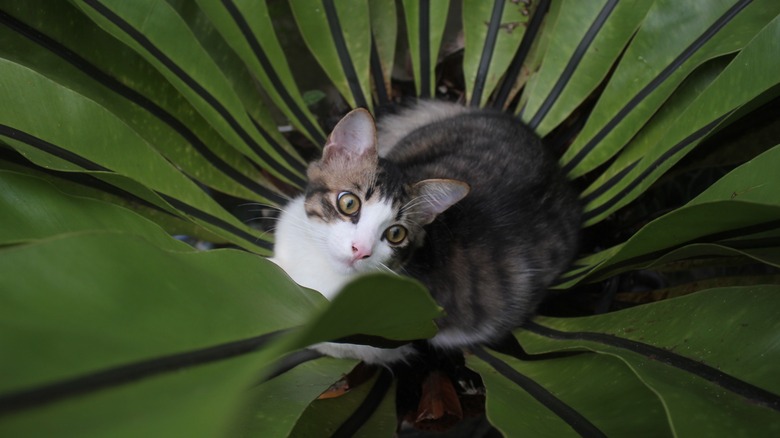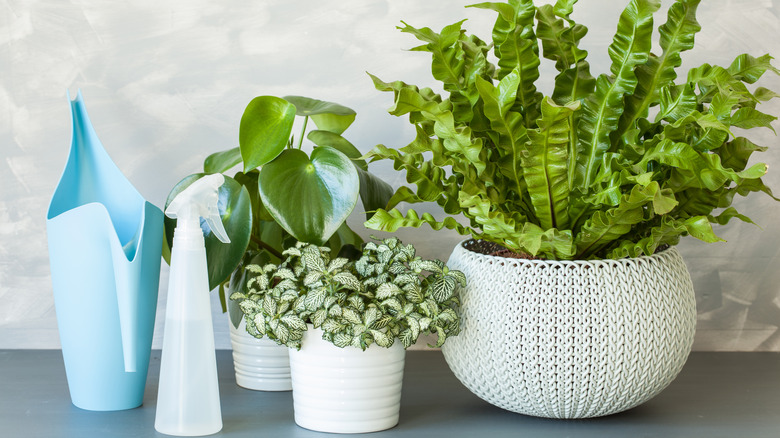How To Grow And Care For A Crispy Wave Fern
The crispy wave, or bird's nest, fern was all the rage back in Victorian England, according to San Diego Zoo's Wildlife Alliance on Animals and Plants. It remains a popular, somewhat easy to care for a house plant to this day. Scientifically classified as asplenium nidus, the crispy wave fern is an epiphytic species, so it does not need to be rooted in the ground. Instead, it can simply sit atop another plant for support and collect all its necessary moisture and nutrients from the air surrounding it. This is why epiphytes are sometimes called air plants.
Asplenium nidus is a slow-growing, evergreen tropical plant with eccentric wavy-edged fronds that unfurl from a tight ball as they grow. It is native to various areas, including Hawaii, Southeast Asia, and Australia. In medieval times, these ferns (and others from the same family) were thought to be of great medicinal value in the case of spleen ailments. This theory earned the Aspleniaceae family its quirky nickname of spleenwort. Ferns are prehistoric plants thought to be around before the dinosaurs. When properly cared for, a crispy wave specimen will brighten your living space while offering a funky-shaped talking point for anyone who stops by for a visit.
How to use a crispy wave fern in the garden
Epiphytes do not tolerate dry environmental conditions, so it is imperative that you live somewhere consistently warm with decent humidity if you would like to use crispy wave ferns as part of your garden layout. In regards to light, ferns are one of those rare plants that do particularly well in the shade. In fact, they need to be kept out of harsh direct sunlight. The NC State Extension Gardener Plant Toolbox advises that crispy wave fronds can grow up to 5 feet when planted outdoors. Leave space for this expansion when initially planting younger, smaller ferns. Given the right growing conditions, they will add a lush, low-lying swath of deep green to a landscape design. In addition, the wavy edges of the unfurling fronds will further delight the visual senses by creating a unique sense of texture.
Crispy wave ferns will also look great in hanging baskets for an eye-level viewing option. Their epiphyte status leaves a lot of room for creativity when searching for the perfect container. Hanging plants will often have more sun exposure, so plan ahead by watching a few areas of your yard throughout the day in order to find a spot that will continue to offer sufficient shade.
How to grow a crispy wave fern
Growing a new crispy wave fern will not be as easy as it is for many other houseplants. Leaf cuttings do not root, and their small, shallow rhizomes do not lend themselves to division, nor do they produce seeds or flowers. So, where does that leave us? Enter the delicate art of propagation by spore. Ferns are native to Australia, so let's go down under for advice on propagating these prehistoric beauties. Gardening Australia compares the spore casings, or sporangia, to caviar, explaining that novice gardeners often mistake them for harmful insects or signs of disease. So, the first step in collecting spores is to scrape the sporangia off the underside of a leaf into a paper bag. Let them sit for a week, and the casings will naturally release the spores. From here, the yellow spores separate from the brown casings. When this is complete, you'll be left with what seems like a fine powder.
Next, prepare a mix of potting bark, peat, and perlite to provide a nutrient-dense growing medium. Pasteurize the growing medium by pouring boiling water over it. Let it cool, then evenly spread the spores over the top by gently shaking the paper bag. At this point, place the grow pot inside a clear plastic zippered storage bag and leave it in a warm and well-lit area. Now, there's nothing left to do but wait three months for the spores to germinate.
How to care for a crispy wave fern
As with most plants, the top two considerations for an indoor fern are water and light requirements. Even though ferns make us think of swampy areas by a babbling brook deep in a humid forest, drainage is still important. Most of all, be sure not to leave them sitting in water. Generally speaking, direct sunlight is also a no-no because it is likely to damage leaves and dry the plant out. Most ferns perform very well in low-light areas, but also bear in mind that shade is not the same as totally dark. Dappled shade from an east or north-facing window is the best option for giving your fern a touch of life-giving sunlight without overdoing it.
Occasional fertilizer will help balance out their nitrogen needs. High humidity is vital, and the same goes for moisture retention in the soil. Misting will not cut it with ferns; they need to live in a humid environment at all times. Also, terra cotta pots are not recommended because they leach moisture. Instead, keep your fern in a plastic grow pot. Since these plants do require attention and regular watering, consider adding their care into your morning routine. Set the alarm, grab your coffee, and spend some quality time taking in the clean air and natural beauty these ferns will bring to your indoor space.
Asplenium varieties
The asplenium genus offers quite a few varieties of wavy, bird's nest-like ferns. Some are smaller with pointier or straighter fronds, while some grow large and wide. And some look like lettuce, while others seem to contain actual movement within their leaves, like the aslpenium antiquum 'Hurricane' pictured above. Here are a few that are definitely worth checking out, courtesy of Florgeous:
- Asplenium antiquum nidus var plicatum 'Lasagne' — This variety has long, particularly ripply-edged fronds that likely remind one of — you guessed it: lasagna noodles.
- Asplenium antiquum 'Leslie' — Is it lettuce? Is it parsley? Nope! It's a crested bird's nest fern with super curly leaves that grow denser than its flowier cousins, Logee's notes.
- Asplenium antiquum 'Osaka' — Also known as the Japanese bird's nest, this fern type has smaller, less pointed fronds with a uniform width. In Japan it is called ō-tani-watar.
- Asplenium antiquum 'Hurricane' — This variety is a newcomer, making a heck of a splash. Viewed from above, the growth pattern of this variety genuinely resembles the swirling of a hurricane as seen by radar.
Is the crispy wave fern toxic?
One of the reasons ferns make great houseplants is that they are generally considered safe and non-toxic for pets and children. As a result, ferns that are accidentally munched on and ingested by a household pet are highly unlikely to cause any noticeable, let alone permanent, harm. But unfortunately, the story doesn't end there because it's possible that an indoor fern can exacerbate allergies in humans. The irritation can be so bad that Bob Vila's publication places ferns at the top of their list of worst houseplants for people with allergies.
The reproductive spores released from the leaves of the ferns enter the air and become irritants similar to pollen. If it's not the usual itchy eyes and sneezing reaction, it could also show up as contact dermatitis, an unpleasant rash resembling poison ivy. Fern allergies are rare, but they can potentially be serious when they are present. So if you or another housemate are suffering behind doors, it may be time to gift that fern or at least find it a new home outside in the garden.
How to repot your crispy wave fern
As epiphytes, crispy wave ferns may not need to be potted, but they absolutely can be quite happy contained in that way. Certainly, as houseplants, your ferns will need the nutrients provided by healthy soil and fertilizer. Aerify Plants identifies three primary reasons to repot. First, overcrowded roots need room to grow. If you see them poking through drainage holes or popping out of the top of the soil, it's time to get to work. Second, rotting or diseased roots need a fresh start, and a new home may set them on a path to recovery. Finally, if it's been more than a year, go ahead and get a new setup ready. Your fern will benefit greatly from a simple soil refresh.
Pick a new planter pot that is 2 inches bigger than the original. A general potting mix will work for soil, but you can also try one configured especially for tropical plants. Add fresh ground to your new pot. Now, gently release your crispy wave fern from its container and examine its root system. This is the best time to use sanitized shears to cut off any dead roots and trim back unhealthy ends. Next, place your trimmed fern into its new home and cover it with more fresh soil. Pressing down the soil around the top of the rootball will help anchor it into place. Now, all it needs is a drink of water.
Fern madness in Victorian England
For reasons unknown, 1840s Victorian England experienced a massive uptick in fern popularity, which included our friend, the crispy wave. For the next 50 years, the British were so crazy for ferns that a well-known author at the time coined the term pteridomania to describe what was going on. From the Latin, pterido means fern, and mania was the only appropriate identifier for the level of adoration and demand to which these little plants arose.
Ferns, ferns, and more ferns. Historic UK explains that it was during this period when both the plants themselves and their images were put on display just about everywhere. Pteridomania was responsible for the fern leaf imprints suddenly found on anything, from home goods to furniture to pre-packaged food items. Those who couldn't afford to maintain a large garden of live plants would keep a small selection in a terrarium. Drying and pressing leaves into albums was also fashionable, as was sketching them in notebooks.
Thanks to the craze, beautiful glasshouses were built to exhibit collections. Called ferneries, some were modest in size. Like the Great Conservatory in the Gardens of the Horticultural Society at Chiswick (pictured above), others were similar to tunnels, hundreds of feet long and 25 to 30 feet high. Per Secrets of Philadelphia, pteridomania made its way across the pond to America towards the end of the British infatuation. You can visit the last original Victorian fernery in the U.S. at Morris Arboretum.
